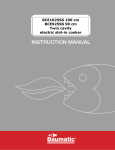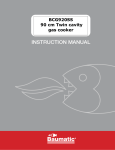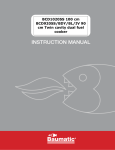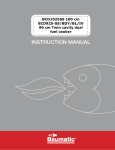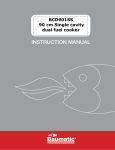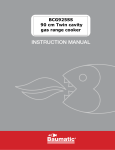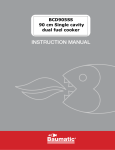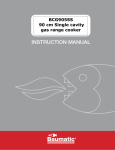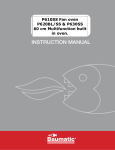Download Baumatic BCE920SS User manual
Transcript
BCE1020SS 100 cm / BCE920SS 90 cm Twin cavity electric slot-in cooker y 1 User Manual for your Baumatic BCE1020SS 100 cm BCE920SS 90 cm Twin cavity electric slot-in cooker with ceramic top NOTE: This User Instruction Manual contains important information, including safety & installation points, which will enable you to get the most out of your appliance. Please keep it in a safe place so that it is easily available for future reference; for you or any person not familiar with the operation of the appliance. GS 12/10/10 2 Contents Environmental note 4 Important safety information 5–9 Specifications Dimensions Specifications Electrical details Control panel Hob surface layout Oven timer 9 – 13 9 9 - 10 10 11 –12 12 -13 13 Setting and using the oven programmer/timer Setting the time of day Setting the minute minder function Setting the duration function Setting the end cook function Setting the start and end time function Returning to manual operation mode The buzzer Changing or cancelling a programmed function 13 -16 13 14 14 15 15 15 16 16 Selecting a cooking function and temperature Using the main oven Cooking functions Using the secondary oven Cooking guidelines Warnings 17 17 17 18 20 20 Using the hob top Before first use Using the hob top cooking zones Hob guidelines 21 -23 21 21 -22 22 –23 Cooking tips 24 -28 Cleaning and maintenance Cleaning the ceramic hob top After each use Cleaning table Replacing the oven bulb Removing the oven door for cleaning Removing the inner door glass for cleaning 28 -32 29 29 29 -30 30 –31 31 32 Installation Positioning Securing the back-guard Fitting the safety chain and hook Electrical connection Connecting the main supply cable 33 33 35 35 36 37 My appliance isn’t working correctly 38 -40 Contact details 41 3 -21 -18 -19 -21 -37 –34 -36 -37 Environmental note o The packaging materials that Baumatic uses are environmentally friendly and can be recycled. o Please discard all packaging material with due regard for the environment. 4 Important safety information Your safety is of the utmost importance to Baumatic. Please make sure that you read this instruction booklet before attempting to install or use the appliance. If you are unsure of any of the information contained in this booklet, please contact the Baumatic Advice Line. General Information o This appliance is designed for domestic household use and for the cooking of domestic foodstuffs. o IMPORTANT: The adjacent furniture and all materials used in the installation must be able to withstand a minimum temperature of 85°C above the ambient temperature of the room it is located in, whilst in use. o Certain types of vinyl or laminate kitchen furniture are particularly prone to heat damage or discolouration at temperatures below the guidelines given above. o Any damage caused by the appliance being installed in contravention of this temperature limit, or by placing adjacent cabinet materials closer than 25 mm to the appliance, will be the liability of the owner. o IMPORTANT: Baumatic Ltd. DO NOT recommend that this appliance is installed on any type of marine vessel. o The use of this appliance for any other purpose or in any other environment without the express agreement of Baumatic Ltd. will invalidate any warranty or liability claim. o Your new appliance is guaranteed against electrical or mechanical defects, subject to certain exclusions that are noted in Baumatic’s Conditions Of Guarantee. The foregoing does not affect your statutory rights. o Repairs may only be carried out by Baumatic service engineers or their authorised service agents. 5 Warning and safety instructions o This appliance complies with all current European safety legislation. Baumatic do wish to emphasise that this compliance does not remove the fact that the appliance surfaces will become hot during use and retain heat after operation. Child Safety o Baumatic strongly recommend that babies and young children are prevented from being near to the appliance and not allowed to touch the appliance at any time. During and after use, all surfaces will become hot. o If it is necessary for younger family members to be in the kitchen, please ensure that they are kept under close supervision at all times. General Safety Make sure that you understand the controls before using the appliance. Check that all of the controls on the appliance are turned off after use. Always stand back when opening the oven door, this will allow heat to disperse. Take care when removing items from the oven, as the contents may be hot. Always keep the oven doors closed when the oven is not in use. Always follow the basic principles of food handling and hygiene; this will prevent the possibility of bacterial growth. Always keep ventilation slots clear of obstructions. Keep fingers away from the hinge areas when closing the door, otherwise you may trap them. Oven gloves should be used when placing food in the oven cavity and when removing it. Care should be taken to avoid direct contact with any of the elements in the appliance. o DO NOT LEAVE THE APPLIANCE UNATTENDED WHILST IN USE. 6 o Do not place heavy objects on the oven door or lean on the oven door when it is open, as this can cause damage to the oven door hinges. Nobody should be allowed to sit or stand on any part of the cooker. o Do not store chemicals, food stuffs, pressurised containers in or on the cooker or in cabinets immediately above or next to the cooker. o Do not heat up unopened food containers, as pressure can build up which may cause the container to burst. o Do not place flammable or plastic items on or near the hob burners, these types of materials should also not be placed in the oven or the compartment below the oven. o Do not leave heated oil or fat unattended, as this is a fire risk. You should not fill a deep fat frying pan more than one third full of fat or oil; you should also not use a lid. o Do not allow fat or oil to build up in the oven trays, grill pan or oven base. o Do not place pans or baking trays directly on the base of the oven cavity, or line it with aluminium foil. o Do not grill food containing fat without using the grill trivet. The grill trivet should never be covered with aluminium foil. o Do not place hot enamel parts in water, leave them to cool first. o Do not allow vinegar, coffee, milk, saltwater, lemon, tomato juice or any liquid with high sugar content to remain in contact with the enamel parts of the appliance. Spillages should be wiped up immediately. o Do not allow electrical fittings or cables to come into contact with areas on the appliance that get hot. o Do not use the appliance to heat the room it is located in or to dry clothing. No clothing should be placed over or near to the hob burners or oven door. o Do not install the appliance next to curtains or soft furnishings. 7 o Do not attempt to lift or move cooking appliances by using the oven door or handle, as this may cause damage to the appliance or result in injury to the person lifting the appliance. Cleaning o Cleaning of the oven should be carried out on a regular basis. o Great care should be taken whilst using this appliance and when following the cleaning procedure. o IMPORTANT: The appliance must be disconnected from the mains before following the cleaning procedure. o IMPORTANT: Care must be taken when cleaning between the door glasses, and inside the inner frame as some of the edges maybe sharp due to the manufacturing process. Installation This appliance must be correctly installed by a suitably qualified person, strictly in accordance with the manufacturer’s instructions. Please see the specific section of this booklet that refers to installation. o Baumatic Ltd. declines any responsibility for injury or damage, to person or property, as a result of improper use or installation of this appliance. o Heat, steam and moisture will be created during use of the appliance, take care to avoid injury and ensure that the room is adequately ventilated. If the appliance is going to be used for prolonged periods of time, then additional ventilation may be required. o Please consult with your qualified installer if you are in any doubt about the amount of ventilation that you will require. Declaration of conformity This appliance complies with the following European Directives: 2006/95/EC regarding “low voltage” 2004/108/EC regarding “electromagnetic disturbances” -89/109/EEC regarding “materials in contact with food”. 8 o The above directives comply with 93/68/EEC regarding CE marking. o The manufacturer declares that the oven is built using certified materials and requires the appliance to be installed in accordance with the standards currently in force. This appliance must be used by a trained person for domestic purposes only. Specifications Product dimensions: BCE1020SS H = Height: h = Height: W = Width: D = Depth: BCE920SS 970 - 980 mm 900 mm 1000 mm 600 mm H = Height: h = Height: W = Width: D = Depth: 945-1000 mm 760 mm 900 mm 600 mm Product specifications: o o o o o 5 zone ceramic hob: 2 x 1.20 kW hyper-speed zone (Ø 140 mm) 2.10 kW hyper-speed zone (Ø 210 mm) 1.20 / 2.20 kW double hyper-speed zone (Ø 140 / 210 mm) 1.20 / 2.20 kW double hyper-speed (Ø 190 / 285 mm) 9 o o o o o o o o o o Left o o o Energy efficiency class: A/A LED full programmer Cooling fan Oven lights Thermostatically controlled grill (main oven) Fixed grill (secondary oven) Double-glazed removable “cool touch” doors Removable full inner glasses Wipe Clean enamelled cavities Adjustable feet oven: Multifunction oven 6 functions Net oven capacity: 50 litres Gross oven capacity: 64 litres Right oven: Static oven with grill o 3 functions o Net oven capacity: 35 litres o Gross oven capacity: 43.5 litres Standard accessories: o WipeClean enamelled baking tray with handle o WipeClean enamelled baking tray o 3 x Safety shelves o Removable side racks o Trivet o Ceramic hob scraper Optional extra: o BPS2 Pizza Stone Electrical details Rated Voltage: Supply Connection: Max Rated Inputs: Mains Supply Lead: Oven Light Bulb: 220 - 240 Vac 50 Hz 55 A (double pole switched fused outlet with 3mm contact gap) 12.15 kW 3 core x 6 mm² (not supplied) E14 15 W/300°C screw type pygmy 10 For future reference please record the following information which can be found on the rating plate and the date of purchase which can be found on your sales invoice. The main rating plate for your oven can be located at the back of the cooker. A smaller rating plate which quotes the serial and model numbers can be found on the inner cavity of the oven or grill door. Model Number ………………………………. Serial Number ………………………………. Date of Purchase ………………………………. Control Panel Thermostat control knob (main oven) o Use this control knob to control the temperature in the oven. Oven function control knob o Use this control knob to select a function for the main oven. 11 Thermostat control knob (secondary oven) o Rotate this control knob to the grill symbol to select the grill oven function. o Turn the control knob to the light icon to switch on the oven light and start the conventional oven function. You can then proceed to set the oven temperature. Hob top cooking zone control knob o Use this control knob to control the power level of the chosen cooking zone. Hob surface layout 12 A) 1.20 B) 2.10 C) 1.20 D) 1.20 kW hyper-speed zone (Ø 140 mm) kW hyper-speed zone (Ø 210 mm) / 2.20 kW double hyper-speed zone (Ø 140 / 210 mm) / 2.20 kW double hyper-speed zone (Ø 190 / 285 mm) Oven timer 1 2 3 5 4 6 1) Minute minder button 2) Cooking time selection button 3) End of cooking time selection button 4) Manual operation mode button 5) Timer minus button 6) Timer plus button D = Digital display Setting and using the oven programmer/timer Setting the time of day After switching on your oven for the first time you should also set the time of day. o After connecting the appliance to the electricity supply, or after a power cut, “AUTO” and “0.00” will flash simultaneously on the digital display. o Press the cooking time selection button (2) and the end of cooking time selection button (3) simultaneously. o Set the current time using the timer minus (5) and timer plus (6) buttons. Once the desired time has been chosen, the “AUTO” symbol will turn off and the cooking time selection icon (2) will turn on. This indicates the oven is in manual operation mode. 13 Setting the minute minder function (main and secondary oven) You are able to set the minute minder at any time, regardless of whether an oven function has been selected. You can set a period of time using the minute minder function and an alarm will sound when this period of time has elapsed. o Press the minute minder button (1) to set a countdown time. o Use the timer minus (5) and timer plus (6) buttons to set the required length of time. You can programme any time between 0.01 min – 0.59 min. o The minute minder symbol (1) will turn on and the countdown will begin automatically after a time is set. o At the end of the set time, a buzzer will sound and the minute minder icon will go off. o Important: The oven will continue to heat once the alarm has been silenced. If you have finished cooking, then you should turn the thermostat control knob to 0. Setting the duration cooking function This function will allow you to set a countdown time similar to the minute minder function. However the oven will no longer continue to heat, once the countdown period has elapsed. o Press the cooking time selection button (2) and use the timer minus (5) and timer plus (6) buttons to set the length of cooking time you require. You can set a time between 0.01 min – 23.59 min. o The “AUTO” and cooking symbols will turn on and remain lit for the time the function is operating. o At the end of the set time, the cooking time selection icon (2) will turn off and the “AUTO” symbol will flash. A buzzer will sound to indicate the end of the cooking time. 14 Setting the end cook function This function is similar to the duration function, however instead of selecting a period of time that you wish the oven to switch off after. You select the time of day that you wish the oven to switch off at. o Press the end of cooking time selection button (3) and use the timer minus (5) and timer plus (6) buttons to set the time of day you wish the function to switch off. You can set a time of day between 0:01 – 23:59 hrs. o The “AUTO” and cooking symbols will turn on and stay on while the function is in progress. o When the programmed time of day is reached, the cooking time selection icon (2) will turn off and the “AUTO” symbol will flash. A buzzer will also sound to indicate the end of cooking time. Setting the start and end time function This function will allow you to set a time in the future that the oven switches on at and a time that the oven will switch off at. o First programme a cooking time using the steps outlined in the ‘Setting the duration cooking function’ section above. Both the “AUTO” and cooking time selection symbol (2) will turn on. o Then programme an end of cooking time using the steps outlined in the ‘Setting the end cook function’ section above. The cooking time selection symbol (2) will turn off. o The cooking time selection symbol (2) will turn on again at the desired oven start time. At the end of the cooking time, the symbol will turn off and the “AUTO” icon will flash. A buzzer will also sound to indicate the set time has been reached. Returning to manual operation mode o You can only return to the manual operation mode when any automatic timer function has finished or been cancelled. o To return to manual operation mode, press the manual operation mode button (4). The “AUTO” icon will disappear and the cooking symbol (2) will turn on. 15 The buzzer o The buzzer will go off at the end of a programme or at the end of the minute minder function. The alarm will last approximately seven minutes before automatically turning off. o The buzzer can be stopped by pressing any of the function buttons. Changing or cancelling a programmed function o An automatic function programming error will occur if the time shown on the clock is between the cooking start time and the cooking end time. This error will be signalled immediately by a buzzer and the “AUTO” symbol will flash. o A setting error can be corrected by altering the duration or end of cooking time. o Any programme that has been set can be corrected at any time by pressing the corresponding programming button and the timer plus (6) and timer minus (5) buttons. o To cancel a programme, change the time set to “0.00”. If a programmed time is cancelled, the end of cooking function is cancelled too and visa versa. o The oven will turn off automatically and the “AUTO” symbol will flash. Press the manual operation mode button (4) to return to manual operation mode. The time of day cannot be corrected when an automatic timer function is in progress. 16 Selecting a cooking function and temperature After your appliance is connected to your mains supply for the first time, the numbers on the timer display will flash. Before you select a cooking function you should set the time of day (see above section for how to do this). Using the main oven You can rotate this dial in either direction to select an oven function for the main oven. The oven temperature control knob should be turned clockwise to select the oven temperature. There are six cooking functions available on your appliance: DEFROST MODE: The fan runs without heat to reduce the defrosting time of frozen foods. The time required to defrost the food will depend on the room temperature, the quantity and type of food. Always check food packaging for the defrosting instructions. FAN OVEN: This method of cooking uses the top and bottom heating elements with the fan. This results in the heat being evenly distributed in the cavity to cook food simultaneously on different shelves and also prevents the transmission of smells and tastes from one dish to another. 17 CONVENTIONAL OVEN: This method of cooking provides traditional cooking, with heat from the top and lower elements. This function is suitable for roasting and baking on one shelf only. GRILL WITH FAN: This cooking method uses the top element in conjunction with the fan, to help give a fast circulation of heat. Suitable where quick browning is required and “sealing” the juices in, such as with steaks, hamburgers, some vegetables etc. CENTRE GRILL: This cooking method is normal grilling, utilising the inner part only of the top element, which directs heat downwards onto the food. Suitable for grilling small portions of bacon, toast, meat etc LIGHT CONTROL: Turn the control knob to this icon to turn the oven light on and off. Using the secondary oven o The control knob should be turned clockwise and used to select the fixed grill function. o Turn the control dial to the light icon to switch on the oven light and start the conventional oven function. You can then proceed to set a temperature for the oven. IMPORTANT: The grill door must be closed when using the grill function. CONVENTIONAL OVEN: This method of cooking provides traditional cooking, with heat from the top and lower elements. This function is suitable for roasting and baking on one shelf only. FULL GRILL: This method of cooking utilises the inner and outer parts of the top element, which directs heat downwards onto the food. This function is suitable for grilling medium or large portions of sausages, bacon, steaks, fish etc. 18 REMEMBER: When using any of the grill functions, it is important to place a drip pan at the base of the oven cavity to collect any juices which may drip down (see image below). The oven walls of the two cavities are fitted with various guide bars on which you can place an oven shelf or a drip tray (see image below). Cooking guidelines o Please refer to the information given on food packaging for guidance on cooking temperatures and times. Once familiar with the performance of your appliance, temperatures and times can be varied to suit personal preference. 19 o Make sure that frozen foods are thoroughly thawed before cooking, unless the instructions on the food packaging advise that you can “cook from frozen”. o You should pre-heat the oven and not place food inside of it until the oven is properly heated. You can choose not to pre-heat when using the fan oven; however you should extend the cooking time given on the food packaging by approximately ten minutes. o Before cooking, check that any unused accessories are removed from the oven. o Place cooking trays in the centre of the oven and leave gaps between the trays to allow air to circulate. o Try to open the door as little as possible to view the dishes. o The oven light will remain on during cooking. Warnings o Keep the oven door closed when using any of the oven functions or the grill cavity. o Do not use aluminium foil to cover the enamelled baking tray or heat items wrapped in aluminium foil under the grill. The high reflectivity of the foil could potentially damage the grill element. o You should never line the base of your oven with aluminium foil. o During cooking, never place pans or cookware directly onto the bottom of the oven. They should always be placed on the shelves provided. o The grill heating element becomes extremely hot during operation, avoid touching it inadvertently when handling the food which you are grilling. o Important: Be careful when opening the door, to avoid contact with hot parts and steam. o IMPORTANT: In case of fire, switch off the electricity supply to the appliance. NEVER pour water onto burning oil. 20 Using the hob top Before first use IMPORTANT: You should clean the hob surface (see “Cleaning and maintenance” section). o You should switch on one cooking zone at a time, for 5 minutes at the maximum setting. This will help to eliminate any new smell that exists and evaporate any humidity that has formed on the heating elements during transit. o Do not burn off more than one zone at once. o You must place a saucepan filled half full with cold water on each zone as you burn it off. Using the hob top zones o Each zone on the ceramic hob top is controlled by a control knob. o To activate a zone, rotate the control knob anticlockwise to choose a power level between 1 – 12. o You should select a control knob position that is suitable for the particular cooking that you are carrying out. o You should always rotate the control dial anticlockwise to move through power levels 1 – 12. For the double cooking zones, this will activate the inner section only. o For the double cooking zones, if you continue turning the control dial anticlockwise, just past power level 12, to the dual zone symbol, this will activate the outer section as well. In this position, both dual zones are set to maximum power. o To control the power level of both the inner and outer sections of the double cooking zones, turn the control dial anti-clockwise to the required power level. 21 o When you have finished cooking on a particular cooking zone, it is important to make sure that the control knob is turned back to 0 (the off position). o For a general guide for cooking with the different power levels please see the table below. Power level 0 1-2 Heat intensity Off Low 3-4 5-6 Moderate Slow 7-8 Medium 9-10 Strong 11-12 Hot Possible cooking process To dissolve butter, chocolate etc. To heat small amounts of liquid. To heat greater quantities of liquid. Thawing frozen food and preparing stews, boiling or simmering. Bringing foods to boiling point. For delicate roasts and fish. For roasts, chops and steaks. For large amounts of boiled meat. Bringing large amounts of water to the boil. Frying. Hob guidelines o The first few times the hob top is used, it may give off an acrid, burning smell. This smell will disappear completely with repeated use. o The worktop is fitted with cooking areas of different diameter and power. o The positions where the heat will radiate from are clearly marked on the hob top. The saucepans must be positioned exactly on these zones for efficient heating to occur. Pans should have the same diameter as the cooking zone that they are being used on. o You should not use saucepans with rough bottoms, as this can scratch the surface. 22 o Before use, make sure that the bottoms of the saucepans are clean and dry. o When cold, the bottom of the pans should be slightly concave, as they expand when hot and lie flat on the surface of the hob. This will allow the heat to transfer more easily. o The best thickness for the bottom of the pans is 2 – 3 mm of enameled steel and 4 – 6 mm for stainless steel with sandwich type bottoms. o If these rules are not followed, then there will be a great loss of heat and energy. Heat not absorbed by the saucepan, will spread to the hob, frame and surrounding cabinets. o Preferably cover pans with a lid to permit cooking at a lower heat. o Always cook vegetables and potatoes, etc. in as little water as possible to reduce cooking times. o For a faster heat up of a zone, you can turn the control knob to 12. Then when the contents of the saucepan are boiling, you may turn the control knob to a lower setting. o Food or liquid that has a high sugar content may damage the hob top if it comes into contact with the hob surface. Any spillages should be wiped up immediately, however this may not prevent the hob surface from becoming damaged. o IMPORTANT: The hob surface is tough; however it is not unbreakable and can be damaged. Especially if pointed or hard objects are allowed to fall on it with some force. o DO NOT USE THE HOB IF THE SURFACE BECOMES BROKEN OR CRACKED. YOU SHOULD CONTACT THE BAUMATIC SERVICE DEPARTMENT IMMEDIATELY. 23 Cooking tips Cooking table for main oven Traditional oven Foods Temperature (°C) Cooking / baking time (mins) 1 1-2 200-225 100-120 190 100-120 1 1-2 200-225 40-50 190 40-50 1 1-2 200-225 100-120 190 100-200 1 1-2 200-225 100-120 190 100-120 1 1 1-2 1-2 225-MAX 225-MAX 50-60 60-70 225-MAX 225-MAX 50 60 1 1-2 225-MAX 50-60 225-MAX 50 1-2 1-2 200-225 80-90 190 70-80 1-2 1-2 200-225 100-120 190 90-110 2-3 1-2 200-225 90-110 190 80-100 1 2 200 30-35 170-190 25-30 1 2 175 20-25 160-170 15-20 2.5 2.5 1 1 2 2 2 2 210-225 210-225 225-MAX 225-MAX 60-75 60-75 25-30 20-25 225-MAX 225-MAX 225-MAX 220 30-40 30-40 20-25 20 2 190 15 170-190 15 2 200 20 190-200 20 2 200 40-45 190-200 40-45 0.8 2 190 52 170-190 45 0.8 0.8 2 2 200 200 65 45 190-200 190-200 65 45 Weight (kg) Meat loafs Roasted veal Roasted beef Roasted pork Roasted lamb Game Roast hare Roast pheasant Roast partridge Poultry Roasted chicken Roasted turkey Roasted duckling Fish Roasted whole fish Sea bass Baked pasta Lasagne Cannelloni Pizza Bread Patisserie Biscuits in general Shortcrust pastry Victoria sponge Cakes / Flans Angel cake / sponge Fruit cake Chocolate cake Combined oven (fan ventilated) Temperature Cooking (°C) / Baking time (mins) Shelf position from bottom 24 The information given in this table is approximate and may vary according to individual needs. Grilling in main oven Traditional oven Foods Meat T-bone steak Steak Chicken (cut in half) Fish Trout Sea bass Sole Bread Toast Combined oven (fan ventilated) Cooking / Baking time Temperature (mins) (°C) 2nd 1st Side Side Weight (kg) Shelf position from bottom Temperature (°C) 0.50 3 225-MAX 15 15 200 10 10 0.15 1 3 2-3 225-MAX 225-MAX 5 25 5 25 200 200 5 18 5 18 0.42 0.40 3 3 225-MAX 225-MAX 18 15 18 15 200 200 10 10-12 0.20 3 225-MAX 10 10 200 10 1012 8-9 3-4 225-MAX 2-3 2-3 200 2-3 2-3 Cooking / Baking time (mins) 2nd 1st Side Side 8-9 The information in this table is approximate and may vary according to individual needs. Cooking table for the secondary oven Conventional oven: Foods Meat loafs Roasted veal Roasted beef Roasted pork Roasted lamb Game Roast hare Roast pheasant Roast partridge Poultry Roasted chicken Roasted turkey Roasted duckling Fish Roasted whole fish Weight (kg) Shelf position from bottom Temperature (°C) Cooking / Baking time (mins) 1 1 1 1 1 1 1 1 220 200-225 220 200-225 80 40-50 80 100-120 1 1 1 1-2 1-2 1-2 225-MAX 225-MAX 225-MAX 50-60 60-70 50-60 1 1-2 200-225 80-90 1 1 1-2 1-2 200-225 200-225 100-120 90-110 1 1-2 200 30-35 25 Sea bass Baked pasta Lasagne Cannelloni Pizza Bread Patisserie Biscuits in general Shortcrust pastry Victoria sponge Cakes / Flans Angel cake / sponge Fruit cake Chocolate cake 1 1-2 175 20-25 2.5 2.5 1 1 1-2 1-2 2 2 210-225 210-225 MAX MAX 60-75 60-75 20-22 20-25 2 190 20 2 200 20 2 200 40-45 0.8 1 190 50 0.8 0.8 1-2 1-2 200 200 65 45 The information in this table is approximate and may vary according to individual needs. Grilling in secondary oven: Foods Meat T-bone steak Steak Chicken (cut in half) Fish Trout Sole Bread Toast Weight (kg) Shelf position from bottom Cooking / Baking time (mins) 2nd Side 1st Side 0.50 0.15 1 3 3 2-3 12 5 25 12 5 25 0.42 0.20 3 3 10 10 10 10 3 3 3 The information in this table is approximate and may vary according to individual needs. Cooking tips for cakes and bread o Heat the oven for at least 15 minutes before you start cooking bread or cakes. o Do not open the door during baking because the cold air will stop the yeast from rising. o When the cake is cooked turn the oven off and leave it in for about 10 minutes. o Do not use the enamelled baking tray or drip pan to cook cakes in. 26 o To test if a cake is cooked, about 5 minutes before the end of cooking time, put a cake tester or skewer in the highest part of the cake. If it comes out clean, the cake is cooked. o If the cake sinks, next time use less liquid or lower the temperature by 10°C. o If the cake is too dry, make some tiny holes with a toothpick and pour some drops of fruit juice or spirits on it. The next time, increase the temperature by 10°C and set a shorter cooking time. o If the cake is too dark on top next time put the cake on a lower shelf and cook it at a lower temperature for longer. o If the top of the cake is burnt, cut off the burnt layer and cover with sugar or decorate with cream, jam and confectioner’s cream. o If the cake is too dark underneath next time place it on a higher shelf and cook it at a lower temperature. o If the cake or bread is cooked nicely outside but is still uncooked inside, next time use less liquid and cook at a lower temperature for longer. o If the cake will not come out of the tin, slide a knife around the edges, place a damp cloth over the cake and turn the tin upside down. Next time, grease the tin well and sprinkle with flour or bread crumbs. o If the biscuits will not come away from the baking tray, put the tray back in the oven for a while and lift the biscuits up before they cool. The next time use a sheet of baking parchment to prevent this happening again. Cooking tips for meat o If, when cooking meat, the time needed is more than 40 minutes, turn the oven off 10 minutes before the end of cooking time to exploit the residual heat and save energy. o Your roast will be juicer if cooked in a closed pan. It will be crispier if cooked without a lid. o Normally white meat, poultry temperatures (less than 200°C). 27 and fish need medium o To cook “rare” red meats, high temperatures (over 200°C) and short cooking times are needed. o For a tasty roast, lard and spice the meat. o If your roast is tough, next time leave the meat to ripen longer. o If your roast is too dark on top or underneath, next time put it on a higher or lower shelf, lower the temperature and cook for longer. o If your roast is undercooked, cut it in slices and arrange the slices on a baking tray with gravy and finish cooking it. Cleaning and maintenance Cleaning operations must only be carried out when the oven is cool. The appliance should be disconnected from your mains supply before commencing any cleaning process. o The oven should be thoroughly cleaned before it is operated for the first time and after each use. This will avoid residual food stuffs becoming baked on the oven cavity. After residues have been baked on several times, they are far more difficult to remove. o Never clean the oven surfaces by steam cleaning. o The oven cavity should only be cleaned with warm soapy water, using either a sponge or soft cloth. No abrasive cleaners should be used. o Any stains that may appear on the bottom of the oven will have originated from food splashes or spilt food, these splashes occur during the cooking process. These could possibly be a result of the food being cooked at an excessively high temperature or being placed in cookware that is too small. o You should select a cooking temperature that is appropriate for the food that you are cooking. You should also ensure that the food is placed in an adequately sized dish and that you use the enamelled baking tray where appropriate. 28 o Outer parts of the oven should only be cleaned with warm soapy water, using either a sponge or soft cloth. No abrasive cleaners should be used. o We would recommend that an appropriate stainless steel cleaner and polish is regularly used on the stainless steel surfaces of this appliance. o If you use any form of oven cleaner on your appliance, then you must check with the manufacturer of the cleaner that it is suitable for use on your appliance. o Any damage that is caused to the appliance by a cleaning product will not be fixed by Baumatic free of charge, even if the appliance is within the guarantee period. Cleaning the ceramic hob top Any residues that are left on the hob top surface from cleaning agents will damage it. You should remove any residues with water and a little washing up liquid. Abrasive cleaners or sharp objects will damage the hob surface; you should clean it using water and a little washing up liquid. Although it is easier to clean some deposits whilst the hob surface is still warm. You should take care not to burn yourself if cleaning the hob surface when it is still warm. After each use o Wipe the appliance over with a damp cloth and a little washing up liquid. o Dry the appliance by rubbing the surface with a clean cloth. Cleaning table Type of deposit Remove immediately? What should I use to remove the deposit? Yes Remove when the appliance has cooled down? No Sugar or food/liquid containing sugar Tin foil or plastic Yes No Ceramic hob scraper 29 Ceramic hob scraper Fat splashes No Yes Metallic discolourations Water splashes or water rings No Yes No Yes Ceramic hob cleaner Ceramic hob cleaner Ceramic hob cleaner Replacing the oven bulb IMPORTANT: The oven must be disconnected from your mains supply before you attempt to either remove or replace the oven bulb. o Draw out the side guide rails in order to provide access to the bulb. Flat lamps o Remove the glass protection cap (C) from the bulb socket by lifting it with a screwdriver placed between the cap and the oven wall. o Replace the bulb (B) with a 15 W/300°C, screw type pygmy. o Do not use any other type of bulb. o Screw the lamp cover back into its original position. 30 Round lamps o Turn the glass protection cap (A) anti-clockwise and change the lamp (B). o Refit the cap by screwing it back in a clockwise direction Removing the oven door for cleaning o The oven door can be removed to give easier access to the oven when cleaning. o Open the oven door and insert a rivet or nail (R) in the hole (F) of the hinge (see image below). o Partially close the door, forcing it upwards at the same time to free the stop tooth and hinge sector. o Once the hinge is free, pull the door forwards tilting it slightly upwards to free the sector. o To reassemble, proceed in the reverse order, playing attention to the correct position of the sectors. 31 Removing the inner door glass for cleaning Ensure the top cavity is cold before cleaning. o Simply open the oven door and remove the support securing the glass. The glass will then slide out easily. o To replace the glass, follow the first step in reverse. WARNING: This procedure can be carried out with the door fitted on the appliance but pay attention that when the glass is pulled upwards, the force of the hinges can close the door roughly. o IMPORTANT: You should make sure that the door is supported at all times and that you place the door on some padded material whilst cleaning it. o The oven door and door glass should only be cleaned using a damp cloth and a small amount of detergent. The cloth MUST NOT have come into contact with any form of cleaning product or chemical previously. 32 Installation The installation must be carried out by a suitably qualified person, in accordance with the current version of the following. o UK Regulations and Safety Standards or their European Norm Replacements. o Building Regulations (issued by the Department of the Environment). o Building Standards (issued by the Scottish Development Department). o IEE Wiring Regulations. o Electricity At Work Regulations. o Gas Safety (Installation and Use) (Amendment) Regulations. Positioning The adjacent furniture and all materials used in the installation must be able to withstand a minimum temperature of 85°C above the ambient temperature of the room it is located in, whilst in use. o Your appliance is heavy, so you should be careful when moving or positioning it. o Do not try to move the cooker by pulling on either the door, handle or control panel. o It can also be used as freestanding, with a cabinet to one side, in a corner setting or with its back to a wall. 33 o IMPORTANT: It should not be installed at the end of a run of cabinets, if there is a cabinet at immediate right angles to the cooker door. o The wall behind the cooker and 450 mm above and across the width of the cooker should be an incombustible material and preferably an easy clean surface, such as ceramic tiles. o Any overhanging surface or cooker hood should be at least 700 mm above the highest point on the hob top (including the burners). o Baumatic do not recommend that the cooker is positioned below wall cupboards, as the heat and steam from the appliance and what is being cooked, may damage the cupboard and its contents. o The cooker may be located in a kitchen, or a bedroom, but not in a room containing a bath or shower. The cooker must not be installed in a bedroom of less than 20m³ in size. o The cooker is fitted with four legs that can be adjusted to match the height of your kitchen cabinets. o If the cooker is not level or is unstable due to an uneven floor surface, use the adjustable feet to alter each corner until the cooker is level. o To assemble them it is necessary to raise the cooker and to screw the four legs into position, on each corner of the base of the appliance. o IMPORTANT: They must be screwed clockwise into position and not just slotted into the holes on each corner. You must screw them through the brackets that are also provided. 34 Securing the back-guard o In order to attach the back-guard (A) to the appliance, you need to loosen the screws (B) positioned on the back of the hob (see image below). o Fix the back-guard into place by screwing the screws back into the hob with the back-guard placed in between. Fitting the safety chain and hook o To prevent the cooker from tipping forward, two lengths of chain MUST BE fixed to the back of the oven which should be secured to the hook provided at all times. o The hook should be secured to the wall at the back of the cooker. The chains should always be attached to the upper hook when the cooker is in position against the wall. o Attach the chain to the lower hook if the cooker is installed with a hose assembly so that there is no strain on the hose when the cooker is pulled forward for cleaning or maintenance. 35 o Fix the upper hook into the wall immediately behind and to the left hand side about 770 mm from the floor. o Secure the chain to the hook before using or cleaning the oven. o To prevent strain on the flexible hose assembly, a lower chain and hook can be fixed approximately 100 mm up from the floor. Electrical connection This appliance must be installed by a qualified person in accordance with the latest edition of the I.E.E. Regulations and in compliance with Baumatic’s instructions. Before connecting the appliance, make sure that the supply voltage marked on the rating plate corresponds with your mains supply voltage. WARNING: THIS APPLIANCE MUST BE EARTHED. o This appliance must be wired into a 55 A double pole switched fused spur outlet, having 3 mm contact separation and placed in an easily accessible position adjacent to the appliance. It should not be located above the appliance and no more than 1.25m away from it. o The spur outlet must still be accessible even when your oven is located in its operating position. 36 o Cable type: H05 RRF 3 core x 6 mm² Connecting the mains supply cable IMPORTANT The wires in the mains lead are coloured in accordance with the following code: GREEN AND YELLOW BLUE BROWN EARTH NEUTRAL LIVE Neutral Terminal N Live Terminal L Cable Clamp Earth Terminal Mains Cable o Connect to the mains terminal block as shown in the image above. It is accessed by removing the cooker back panel. o The power cable must be laid so that no parts of it ever reach a temperature of 75°C. o For connecting do not use adapters or shunts as they could cause false contacts resulting in hazardous overheating. o When connecting directly to the mains, install a multi-polar switch that can withstand the appliance load, with a minimum opening between the contacts of 3 mm. 37 My appliance isn’t working correctly o The oven isn’t coming on. * Check that the oven is in manual operation mode. * Check that you have selected a cooking function and a cooking temperature. o There appears to be no power to the oven and grill. * Check that the appliance has been connected to the electrical mains supply correctly. * Check that the mains fuses are in working order. * Check that the operating instructions for setting the time of day and putting the appliance into manual operation mode have been followed. o The grill function works but the main oven does not. * Check that you have used the correct control knob to switch on the oven. o The grill and top oven element is not working, or cuts out for long periods of time during use. * Allow the oven to cool for approximately 2 hours. Once cool, check whether the appliance is again working properly. o My food is not cooking properly * Ensure that you are selecting the correct temperature and the correct cooking function for the food that you are cooking. It may be appropriate to adjust your cooking temperature by plus or minus 10°C, to achieve the best cooking results. o My food is not cooking evenly * Check that the oven has been installed correctly and is level. * Check that the correct temperatures and shelf positions are being used. 38 o The oven light is not working * Refer the “Replacing the oven bulb” section. o I am getting condensation in my oven * Steam and condensation is a natural by product of cooking any food with high water content, such as frozen food, chicken etc. * You may get condensation in the oven cavity and forming between the oven door glasses. This is not necessarily a sign that the oven is not working correctly. * Do not leave food in the oven to cool after it has been cooked and the oven has been switched off. * Use a covered container, where practical, when cooking to reduce the amount of condensation that forms. * Steam and condensation may appear from the vent at the rear of the appliance when cooking food with high water content. This is normal and any excess should be wiped away. 39 IMPORTANT: If your appliance appears not to be operating correctly, then you should disconnect it from your mains supply and then contact Baumatic Customer Care on telephone number (0118) 933 6911. DO NOT ATTEMPT TO REPAIR THE APPLIANCE YOURSELF. Please note that if an engineer is asked to attend whilst the product is under guarantee and finds that the problem is not the result of an appliance fault, then you may be liable for the cost of the call out charge. The appliance must be accessible for the engineer to perform any necessary repair. If your appliance is installed in such a way that an engineer is concerned that damage will be caused to the appliance or your kitchen, then he will not complete a repair. This includes situations where appliances have been tiled in, sealed in with sealant, have wooden obstructions placed in front of the appliance, like plinths. Or any installation other than the one specified by Baumatic Ltd. has been completed. Please refer to the conditions of guarantee that appear on the warranty card that you receive with the appliance. IMPORTANT: Baumatic Ltd. operates a policy of continuous improvement and reserves the right to adjust and modify its products without prior notification. 40 United Kingdom Baumatic Ltd Baumatic Buildings, 6 Bennet Road, Reading, Berkshire RG2 0QX United Kingdom Czech Republic Baumatic CR spol s.r.o. Průmyslová zóna Sever 696 460 11 Liberec 11 Czech Republic Sales Telephone (0118) 933 6900 Sales Fax (0118) 931 0035 Customer Care Telephone (0118) 933 6911 Customer Care Fax (0118) 986 9124 Spares Telephone (01235) 437244 Advice Line Telephone (0118) 933 6933 www.baumatic.cz +420 483 577 200 Slovakia Baumatic Slovakia, s.r.o. Galvániho 7/D Slovakia +421 255 640 618 Germany Baumatic Gmbh Lilienthalstrasse 1 320 52 Herford Deutschland E-mail: [email protected] [email protected] [email protected] [email protected] +49 5221 694 99-0 www.baumatic.de Italy Baumatic Italia S.R.L. Via Galvani N.3 35011 Campodarsego (PD) Website: www.baumatic.co.uk Republic of Ireland +3904 9920 2297 Service Telephone 1-890 812 724 www.baumatic.it Spares Telephone 091 756 771 Holland Baumatic Benelux B.V. Grindzuigerstraat 22 1333 MS ALMERE Nederland +3136 549 1555 www.baumatic.nl 41 42 43 44












































